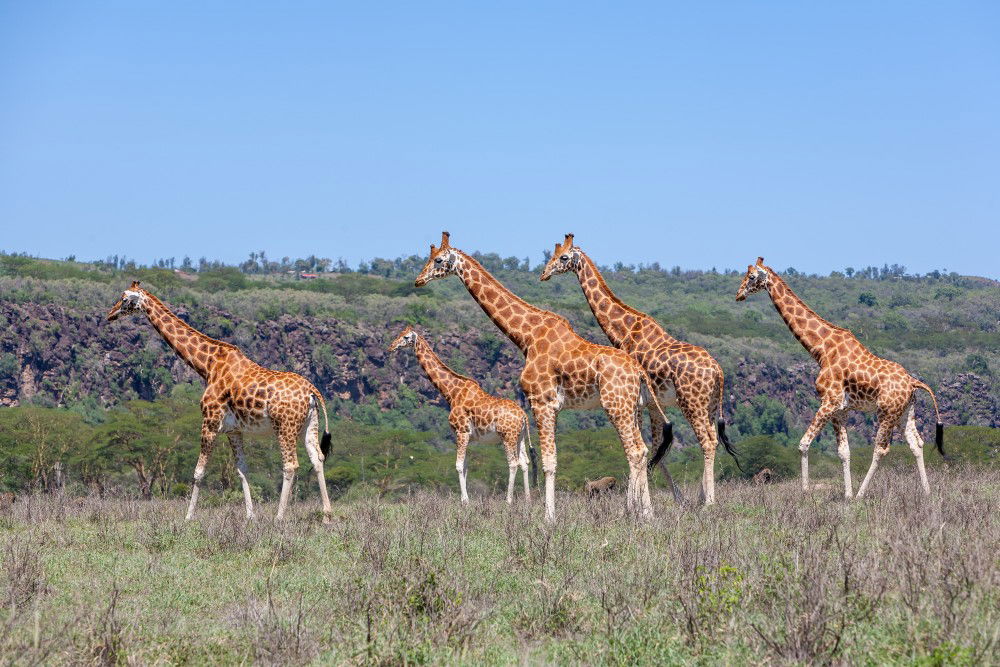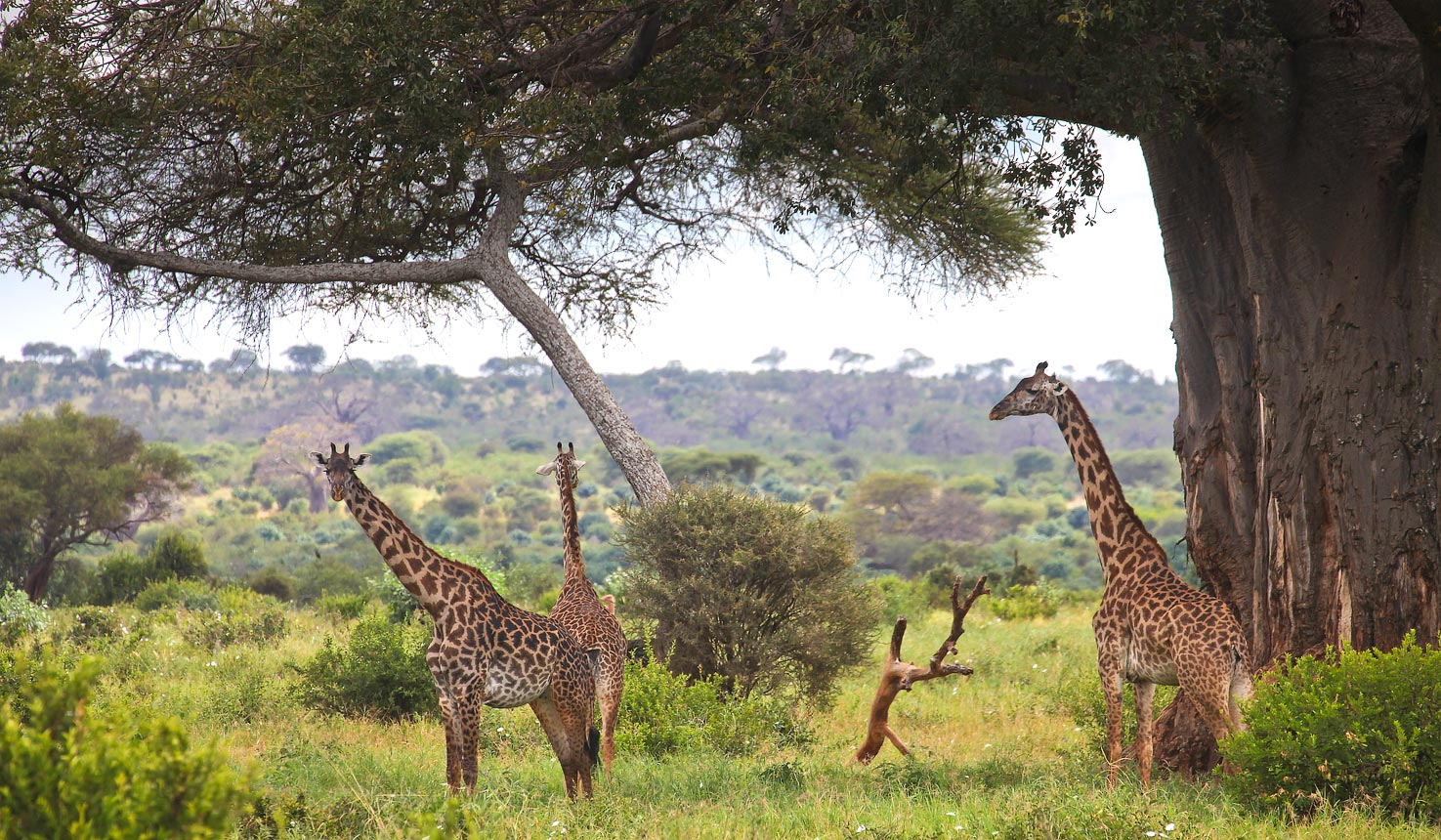We’ll explore the fascinating world of the giraffes, from their long necks to their unique patterns.
Giraffes are the tallest of all land animals; males (bulls) may exceed 5.5 metres (18 feet) in height, and the tallest females (cows) are about 4.5 metres. They can browse foliage almost six metres from the ground using prehensile tongues almost half a metre long.
Giraffe, (genus Giraffa), is any of four species in the genus Giraffa of long-necked cud-chewing hoofed mammals of Africa, with long legs and a coat pattern of irregular brown patches on a light background.
Giraffes are a common sight in grasslands and open woodlands in East Africa, where they can be seen in reserves such as Tanzania’s Serengeti National Park and Kenya’s Amboseli National Park. We have curated safaris that guarantee sightings of the giraffes in their natural habitat.
The genus Giraffa is made up of the northern giraffe (G. camelopardalis), the southern giraffe (G. giraffa), the Masai giraffe (G. tippelskirchi), and the reticulated giraffe (G. reticulata).

Early Sightings of the Giraffes
Paintings of giraffes appear on early Egyptian tombs; just as today, giraffe tails were prized for the long wiry tuft hairs used to weave belts and jewellery. In the 13th century, East Africa supplied a trade in hides.
During the 19th and 20th centuries, overhunting, habitat destruction, and rinderpest epidemics introduced by European livestock reduced giraffes to less than half their former range. Today giraffes are numerous in East African countries and in certain reserves of Southern Africa, where they have somewhat recovered. The West African subspecies of the northern giraffe is reduced to a small range in Niger.
This iconic six-metre-tall herbivore used to roam 28 African countries, but is now extinct in at least seven: Burkina Faso, Eritrea, Guinea, Mali, Mauritania, Nigeria, and Senegal.
Physical Attributes
Giraffes grow to nearly their full height by four years of age but gain weight until they are seven or eight. Males weigh up to 1,930 kg (4,250 pounds), and females up to 1,180 kg (2,600 pounds).
The tail may be a metre in length and has a long black tuft on the end; there is also a short black mane.
Both sexes have a pair of horns, though males possess other bony protuberances on the skull.
The back slopes downward to the hindquarters, a silhouette explained mainly by large muscles that support the neck; these muscles are attached to long spines on the vertebrae of the upper back. There are only seven neck (cervical) vertebrae, but they are elongated. Thick-walled arteries in the neck have extra valves to counteract gravity when the head is up; when the giraffe lowers its head to the ground, special vessels at the base of the brain control blood pressure.
Neck: One of the distinguishing characteristics of a giraffe is its long neck. This allows giraffes to reach the highest leaves and shoots up in the Acacia tree (their favourite food source), which other browsers cannot reach, whilst also keeping an eye out for predators from their vantage point. The neck is also used for ‘necking’ in Bulls. This is a ritualised fight that appears to help establish dominance and involves repeatedly swinging their neck to deliver head-butts to the other bull on their body and belly. The giraffe’s neck has a very complex system that regulates their blood pressure, ensuring that plenty of blood gets to their brain but not too much when they bend down to take a drink.
Horns: Giraffes’ horns are known as ossicones and are found in both males and females, they are formed from ossified cartilage and covered in skin and hair. Both males and females are born with their ossicones but they lie flat at birth and are not attached to the skull to avoid injury to themselves and the mother, fusing to the skull as they grow older. Interestingly male giraffes often have thicker ossicones than females, which become bald on top due to frequent necking.
Spots: Each giraffe has a pattern of spots that is unique to them, much like a human’s fingerprint. Their spots also have far more use than the obvious camouflage they provide and around each spot is a large blood vessel which branches off in a complex system of blood vessels underneath the spot. A giraffe can send blood through these smaller blood vessels into the middle of each patch to release heat from the body.
Behaviours of the Giraffes
Calves are about two meters tall and grow rapidly as much as two and a half centimetres a day. By two months, the calf will start eating leaves and at six months is fairly independent of its mother. A young giraffe can even survive early weaning at two or three months. Although few predators attack adults, lions, hyenas, and leopards take their toll on the young. Scientists report that only one-quarter of infants survive to adulthood due to the high rates of predation.
Diet
Giraffes are extremely picky eaters
Giraffes prefer to eat new shoots and leaves, mainly from the thorny acacia tree. Cows in particular select high-energy low-fibre items. They are prodigious eaters, and a large male consumes about 65 kg (145 pounds) of food per day.
The tongue and inside of the mouth are coated with tough tissue as protection. The giraffe grasps leaves with its prehensile lips or tongue and pulls them into the mouth. If the foliage is not thorny, the giraffe “combs” leaves from the stem by pulling it across the lower canine and incisor teeth.
Giraffes obtain most water from their food, though in the dry season, they drink at least every three days. They must spread the forelegs apart to reach the ground with the head.
They feed 16 to 20 hours a day, but may only consume about 30 kilograms (about 30 pounds) of foliage during that time. These two-ton mammals can survive on as little as seven kilograms (15 pounds) of foliage per day. While these browsers’ diverse diets have been reported to contain up to 93 different plant species, acacia trees are their favourite food source.
They are not heavy drinkers
Giraffes drink water when it is available, but they don’t need to drink water daily, which allows them to survive in areas with scarce water.
Why are Giraffes Important

Giraffes are vital to keeping ecosystems in balance. They eat the browse that others cannot reach, which promotes the growth of forage and opens up areas for themselves and other smaller browsers to make use of. Importantly this means that by protecting Africa’s giraffes, we are protecting other species too. Giraffes’ lives are so intertwined with Acacia trees that some seedlings do not germinate until they have passed through a giraffe’s digestive system.
Challenges Faced by Giraffes
Humans hunt giraffes for their hides, meat, and body parts.
Many African cultures highly prize giraffe tails, which are used in good-luck bracelets, fly whisks, and even thread for sewing or stringing beads. However, the world’s tallest land animal has lost 40 percent of its population in just 30 years, and recent reports show poaching and wildlife trafficking are contributing to this decline. Giraffes are easily killed, and poaching (now more often for their meat and hide) continues today.
Giraffes are quickly losing their living spaces.
The number of giraffes in the wild is shrinking as their habitats shrink. In the late 19th and 20th centuries herds of 20 to 30 animals were recorded, now on average herd sizes contain fewer than six individuals. The IUCN lists four main threats to this species: habitat loss, civil unrest, illegal hunting, and ecological changes (climate change and habitat conversion). As human populations grow and increase agricultural activities, expand settlements, and construct roads, the giraffe is losing its beloved acacia trees, which are its main source of food.
Discover the Heart of the Wild
Ready to witness the mesmerising African Wild Dogs up close? There’s nothing quite like the thrill of seeing these wild dogs in their natural element. Prepare for heart-pounding moments, unforgettable encounters, and stories you’ll tell for years to come!
Get ready for a safari adventure like no other!





